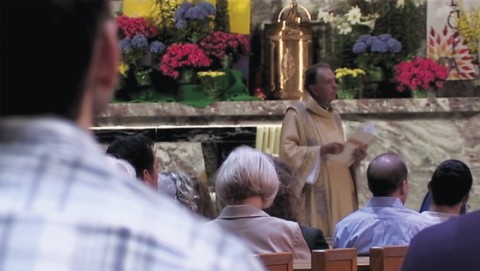Victims in collars

Antagonists are like alligators,” my friend said. “There’s one in every pond.” All those in the room who had been pastors chuckled knowingly. The documentary film Betrayed: The Clergy Killer’s DNA claims that “clergy killers” are leading many clergy into depression, early retirement and even suicide.
Lloyd Rediger, a Presbyterian minister, coined the phrase “clergy killers” in a 1997 book, and he has gone on to produce a film. Betrayed is the first of a planned four-part series. I learned about it from a minister who has struggled with people in her parish seemingly put there by Beelzebub to torment her. While not exactly entertaining, the film is well made and features interviews with thoughtful people. The film is based on interviews with mainline pastors in many denominations, and Rediger has promoted his film with mainline bloggers and by showing the film at clergy conferences.
Read our latest issue or browse back issues.
While the film creates an aura of paranoia, its claims are worth attending to: “50 percent of congregations worldwide are under attack,” the publicity materials say, and “1,500 ordained clergy leave active ministry every four weeks.” (The Barna Group is cited as a source.) The way to end this destruction, the film suggests, is by creating a union of ministers, like that in the United Church of Canada (as if that church is doing so well) or by using lawyers, who, we are assured, are ready to take on our cases.
The premise is, in some senses, indisputable. Who among clergy does not know a pastor who has been unfairly targeted and treated badly by their congregation? Yet put so baldly, the kvetch seems odd. The film’s cover has a dark sanctuary, with a forlorn cleric bowing in prayer, and the word betrayed in red with the line: “When the church forsakes its own clergy.”
I left the video out on a coffee table at my parsonage for months, trying to work up the courage to watch a documentary promising to be as much fun as a film about microbial mutation. Visitors reacted strongly. “Hm,” one snorted, “What about churches forsaken by clergy?”
Of course there are clergy killers in the congregation. There are also church killers among the clergy. The reason is as basic as the Christian faith: we are all descendants of Cain, the first murderer. God comes among us in Christ as the one murdered, who rises with forgiveness in place of judgment. A clergy killer presumably thinks she is altogether right and the clergy altogether wrong. This film displays the same Manichean split between one side’s entire wrongness and the other side’s perfect justice.
Interviewees get apoplectic about clergy killers’ meanness and judicatory leaders’ tepid defense of them; the only saviors are the secular ones of unions and lawyers. This is a simple world where the innocent ones in collars are attacked and meek shepherds are unaware that a wolf is loose among their flock.
Like other clergy, I have had parishioners come after me in ways and for reasons that were unjustified. What did I do? Lined up defenders, made known the identities of the attackers and got out of the way while others defended me. This has not only worked; it has taught me a great deal. The people coming after me have their own demons, and thankfully in many cases they have come back to the congregation and felt heard by me, perhaps even loved.
“You are under attack,” a friend told me one Sunday, leaving me unspeakably grateful for naming it. He then proceeded to detail the litany of charges against me in a way that suggested that the hordes were being held back only by my few defenders, leaving me feeling more anxious. I mentioned the episode to another lay leader. He said, straight-faced, “Reminds me of when the mob came after me early in my career. Threatened my family. Had to get the FBI involved. That was hard.” So maybe I was whining.
This film’s dark music, feigned outrage, ominous use of terms like pandemic and statistics purporting to record the loss of clergy strike me as maudlin clerical self-pity. Eventually the interview subjects are asked their view of evil, demonic possession, the devil, Jesus’ unforgivable sin—things we’re normally asked about only on youth retreats. While most of the interview subjects are some variety of mainline pastor, none is willing to rule out the presence of the worst sort of evil. The only hints of hope are vague. One interviewee says those who do evil will be held “financially responsible.” That is comforting.
A relentless theme is the lack of support for clergy from denominational authorities. According to the film, the hierarchy is full of functionaries and cowards who at best stand aside and at worst are complicit in evil, who are more worried about money and reputation than they are about defending the pastors in their charge. The theme has the feel of inevitability. Those in power must be corrupt; those without must not be. Sometimes this is the case.
Yet I have also known bishops and other authorities with great courage, quiet faithfulness and good old-fashioned kindness. Simply being in power does not make one corrupt. And simply being mistreated does not make one virtuous—a victim is not necessarily a saint.
The film’s best section is its description, in detail completely lacking elsewhere, of the fate of one pastor. Robert Matton was a minister in the United Church of Canada who was dismissed for no clear cause. His widow describes the way he cleaned out his study of sermon materials and left the lot of boxes on the curb for the garbage collector. Then the two went for a walk. He collapsed two blocks later and died of a heart attack. His former church went on to have a memorial service for their fired pastor to which his family was not invited. The heartache, which is sensitively depicted, invites us to imagine similar things happening elsewhere.
I am still left wondering: Do we have so few resources to deal with “evil” that we must turn to unions and lawyers? If pastors indeed need more backbone, aren’t there some morally weighty resources to bring to bear, namely, scripture, tradition and the Crucified One who is the heart of the church? His forgiveness of enemies was not license to be walked over; it was its own sort of power, one validated in his resurrection.
St. Paul dealt with no small amount of conflict in his congregations and was not afraid to name specific sins. Yet his gospel was one of the astonishing faithfulness of God to bring about reconciliation beyond our comprehension. Wherever there is church, there is conflict with evil. We have resources from our own treasure house. They are entirely ignored in this documentary.
Stories of pain are resolutely particular and should never be diminished. But the way this film tells the story stresses the moral obviousness of the issue and the total innocence of its heroes. It is a morally simple and satisfying universe. It’s just not the one we live in.





